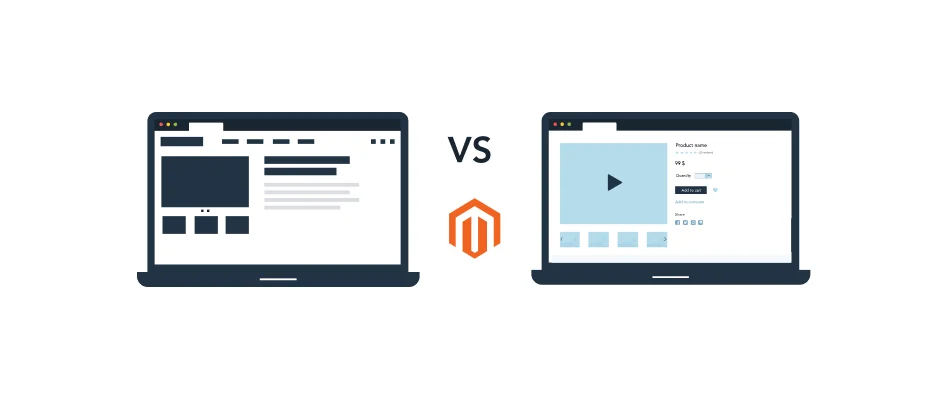The Ultimate Guide to Magento Theme Development:
Custom Design vs. Ready-Made Templates

The Ultimate Guide to Magento Theme Development:
Custom Design vs. Ready-Made Templates
Share post
Magento is known as a big player in the ecommerce world. The platform has rich functionality with dozens of customization opportunities offered to its customers. Still, there are some factors that require extra focus from entrepreneurs when composing or scaling their Magento store. So, why is Magento theme development a subject for discussion among many experienced business leaders and marketers?
Magento theme design is crucial for your website. A well-built and fully functional ecommerce store usually attracts more customers, thus leading to higher turnover and profits. It is also worth mentioning that most online shoppers report they will not return to a website after a disappointing user experience. In other words, the more stunning, convenient, and feature-rich your website is, the better.
That is the point at which the question about customizing Magento occurs. Which option is better to fit your unique requirements? Should you choose a custom Magento theme or ready-made templates? In this article, we will dive into the benefits and drawbacks of selecting each option.
Table of Contents
ToggleWhen it comes to the types of Magento store design, you’ll have to choose between ready-made Magento theme templates and custom themes built from scratch in accordance with your requirements.
But what type of Magento theme design can help you get top-notch visuals and a brilliant interface? What is the best solution to showcase your brand identity and values? Let’s compare these two options and weigh their pros and cons below.
Various online resources offer numerous theme templates that can be customized according to your requirements and used quickly. These are usually ready-made themes designed to fit different industries. For example, if you own an accessories and clothing store, you can choose any premade fashion theme. In this case, you will get a ready-made template with the design and functionality that meet the requirements of the most up-to-date fashion industry trends. Your website will have a style, layout, and pages that are common to your niche and that can represent your products in the best way to encourage your customers to make purchases.
Once you shop for a prebuilt Magento store template, you need to install it and select font options, brand colors, and layout styles to customize your default theme. After making these selections, your website design is ready, and you can move on to the next step, namely, adding your products. Although the process of editing a new theme is easy and straightforward, using it still has some drawbacks. Below, you can find a list of pros and cons of using a standard Magento theme template.
While ready-made templates are convenient and often more cost-effective, they are typically used by multiple users. If you want a unique look and additional customization, opting for a custom Magento theme development is usually more beneficial.
Unlike the ready-made Magento themes, the customized one allows you to create a custom Magento design for your online store. You can use as many elements as you want to create a unique look for specific pages, and customize other aspects of your online store.
If you want your ecommerce website to look original and have top-notch functionality, you can choose the custom Magento design solution. With the help of professional Magento theme development services, you can transform your vision into a highly functional, branded online store.
Here is a list of pros and cons of using a custom Magento theme development for your ecommerce website:
The final decision between website templates and custom Magento design depends on different factors, including your budget limits, timeline, desired uniqueness, and the technical requirements of the final product.

Custom Magento theme design offers significant benefits for businesses. But how can custom themes improve your ecommerce project?
Bringing your creative ideas to life can help you customize your website and develop a truly unique branded user experience that highlights your business values, mission, and value proposition. It will allow you to stand out from your competitors, have an original website with all the needed functions available to your customers. Professional Magento theme customization can reflect your brand’s unique style and appeal to your target audience.
Not only should your ecommerce store be well-designed and stylish. It must load fast and provide a smooth and trouble-free browsing experience for your website’s visitors. Magento theme development is performed exactly for these purposes.

When using a custom theme, you can always be sure your website performance is smooth and reliable. Moreover, a branded website can help you significantly improve navigation, add the most up-to-date functionality, and provide a seamless shopping experience for your clients that leads to better user experience and higher conversions.
Being fully responsive is a must for any modern ecommerce website. Your online store should work perfectly on most types of devices with different operating systems, screen sizes, and other parameters. Custom Magento 2 theme development can help you achieve these goals.
Custom themes can be integrated with dozens of Magento extensions and services. They allow you to get many additional features and functionality to suit all your business needs. Common third-party integrations include the following:
It is important to note that predesigned Magento templates also allow different types of third-party integrations. Still, the conflicts and incompatibilities with diverse tools might often occur. As a result, you may face serious errors and bugs when using premade themes.
The good news is that in case you choose a custom Magento theme design, you have full access to your theme. Consequently, you can edit the code and manage your theme according to the unique needs of your business eliminating any incompatibility issues with third-party solutions. This approach ensures smoother and trouble-free performance of your website. In rare cases when a certain bug appears, it is easy to detect and fix it.
Magento 2 theme development is usually a complicated process. You need to take into account numerous parameters to make sure the final template for your website has a flawless performance. Here is what it is necessary to take into account:
Using diverse colors from a similar color palette can easily make your website look unprofessional. The same rule works for typography, styles of images, and other visual parameters. Therefore, it is crucial to follow all the rules of your brand book when working on your website design.
Being responsive on all types of devices is crucial for any ecommerce website. You need to keep in mind all responsive theme guidelines to make sure your website looks good on most types of desktop and mobile devices. This includes using fluid grids, flexible images, and media queries.
It is always a good idea to customize the header, footer, and other elements of your Magento theme. For example, you can include custom navigation menus, integrate social media icons, or add a search bar to the header. You can also consider incorporating links to key pages, essential contact details, or copyright information in your website’s footer.
After you’ve developed your custom Magento theme, it’s important to perform testing to verify its functionality and eliminate any bugs. The theme must be tested across various devices and browsers to confirm seamless operation.
Magento 2 theme development is often a challenging task, even for some experienced users. That’s why for this kind of Magento store customizations you should either have in-house developers or outsource an experienced development team that will do it for you.
Magento custom design is focused on creating a unique visual appearance and user interface for Magento-based ecommerce websites. This includes developing a theme that aligns with your brand’s identity, meets unique business needs, and improves the overall user experience. The crucial aspects of Magento theme development include the following:
Creating a custom Magento theme design usually involves collaboration between web designers, developers, and business stakeholders. The process is targeted to make sure the final product meets all your requirements and provides an engaging shopping experience for your customers.
If you start cooperation with an experienced Magento company, all the rules of Magento customization will be strictly followed. Moreover, developers, designers, and testers who are true experts in Magento theme development, will create a website for you quickly and effectively.
So, is custom Magento theme development truly needed? As we’ve mentioned above, choosing between ready-made Magento 2 themes and custom design depends on your unique needs, time, and budget. However, customized Magento development will more likely meet all your needs if you want a fresh, fully functional, and unique ecommerce website.
It’s up to you to decide on the color palette and the list of features, however, if you choose custom theme development, make sure that you choose an experienced Magento development team to work on your website’s custom design. This is vital!
Still got any questions about custom Magento themes? Be sure to reach us through our contact form. We will be happy to answer all your questions and assist you in bringing your project to life!
Share This Article
 >
>  12 Best Free Magento 2 Themes for a Stunning Ecommerce Website in 2024
12 Best Free Magento 2 Themes for a Stunning Ecommerce Website in 2024